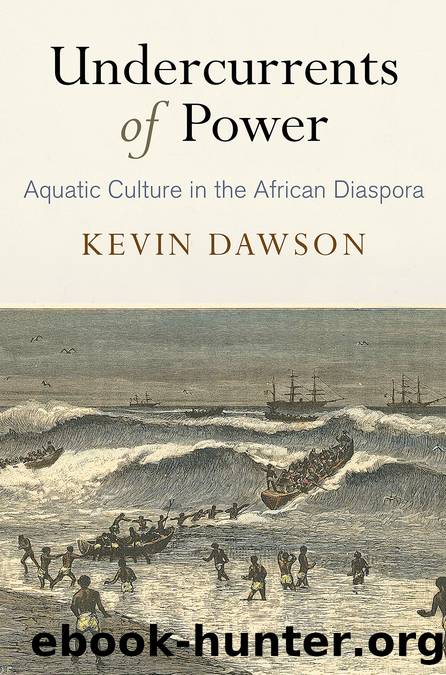Undercurrents of Power by Kevin Dawson

Author:Kevin Dawson
Language: eng
Format: epub
Publisher: Lightning Source Inc.
Published: 2018-11-14T16:00:00+00:00
Figure 25. âCanoe on the Bonny River.â This photograph details the size and intricacies of figureheads mounted on some riverine dugouts. Joseph H. Reading, Voyage Along the Western Coast or Newest Africa: A Description of Newest Africa, or the To-day and the Immediate Future (Philadelphia: 1901); opposite 70. Authorâs collection.
In the tropical Americas, many slaves constructed dugouts from silk cottonwoods. If we take the Americas in their entirety, sources suggest most slave-built canoes were hewn from cottonwoods. Different genera are found throughout the tropics. All are ideal for canoe construction.36
Amerindians probably told some African-born captives which New World trees possessed desirable qualities. Others learned through trial and error, undoubtedly applying their botanical knowledge to the process. Cedar was used on arid Caribbean islands, as it is decay- and insect-resistant, lightweight, and strong. Dugouts in the Danish West Indies were âconstructed from cedar, which are subject to neither worms nor rot.â37
Bald cypress (Taxodium distichum) was commonly used in the American South. Its easily worked timber is called âthe wood eternalâ and is ideal for construction where resistance to water, decay, and insects is needed.38 The Liriodendron tulipifera of the American Southeast is commonly dubbed the tulip tree or yellow poplar but was also âcalled Canoe-wood.â39
Download
This site does not store any files on its server. We only index and link to content provided by other sites. Please contact the content providers to delete copyright contents if any and email us, we'll remove relevant links or contents immediately.
Machine Learning at Scale with H2O by Gregory Keys | David Whiting(4258)
Never by Ken Follett(3882)
Harry Potter and the Goblet Of Fire by J.K. Rowling(3808)
Unfinished: A Memoir by Priyanka Chopra Jonas(3356)
Fairy Tale by Stephen King(3307)
The Man Who Died Twice by Richard Osman(3040)
Will by Will Smith(2872)
Rationality by Steven Pinker(2327)
The Dark Hours by Michael Connelly(2280)
Can't Hurt Me: Master Your Mind and Defy the Odds - Clean Edition by David Goggins(2276)
It Starts With Us (It Ends with Us #2) by Colleen Hoover(2255)
The Storyteller by Dave Grohl(2198)
Friends, Lovers, and the Big Terrible Thing by Matthew Perry(2182)
The Dawn of Everything: A New History of Humanity by David Graeber & David Wengrow(2156)
The Becoming by Nora Roberts(2150)
The Stranger in the Lifeboat by Mitch Albom(2093)
Cloud Cuckoo Land by Anthony Doerr(2058)
Love on the Brain by Ali Hazelwood(2024)
Einstein: His Life and Universe by Walter Isaacson(1985)
